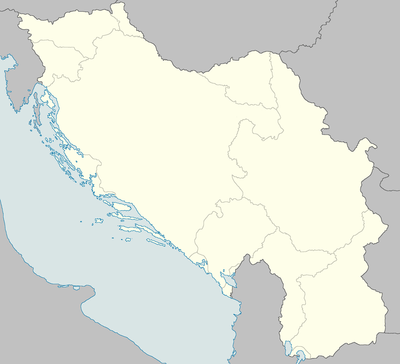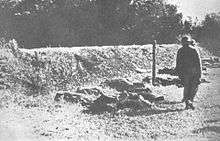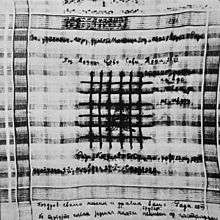Banjica concentration camp
| Banjica | |
|---|---|
| Concentration camp | |
|
A German soldier points his rifle at a prisoner in Jajinci, which served as an execution site for Banjica inmates. | |
 Location of Banjica within occupied Yugoslavia | |
| Coordinates | 44°46′15″N 20°28′03″E / 44.77083°N 20.46750°ECoordinates: 44°46′15″N 20°28′03″E / 44.77083°N 20.46750°E |
| Location | Banjica neighbourhood, Belgrade, Territory of the Military Commander in Serbia |
| Operated by | Gestapo, Belgrade Special Police and Serbian State Guard |
| Operational | 5 July 1941 – 3/4 October 1944 |
| Inmates | Primarily Serbs, Jews, Roma and anti-fascists |
| Number of inmates | 23,697 |
| Killed | > 3,849 |
The Banjica concentration camp (German: KZ Banjica) was a German[1] concentration camp in the Territory of the Military Commander in Serbia[2] during World War II. Located in the Banjica neighborhood of Dedinje—a suburb of Belgrade—it was originally used by the Germans as a center for holding hostages. The camp was later used to hold Serbs, Jews, Roma, captured Partisans, Chetniks and other opponents of Nazi Germany. By 1942, most executions occurred at the firing ranges at Jajinci, Marinkova Bara and the Jewish cemetery.
Banjica was operational from July 1941 to October 1944. It was jointly run by German occupying forces under the command of Gestapo official Willy Friedrich and the Serbian State Guard. The Serbian administrator of the camp was Svetozar Vujković, a pre-war policeman who enthusiastically collaborated with the Germans. Later, both he and Friedrich were tried, found guilty and executed for war crimes by Yugoslavia's post-war communist authorities. 23,697 individuals were detained in Banjica throughout the war, at least 3,849 of whom perished. After the war, a small monument dedicated to the victims of the camp was constructed. The Museum of the Banjica Concentration Camp was opened in 1969, and contains more than four hundred items relating to the camp and its operation.
Background
On 6 April 1941, the Axis powers invaded the Kingdom of Yugoslavia. Poorly equipped and trained, the Royal Yugoslav Army (Serbo-Croatian: Vojska Kraljevine Jugoslavije; VKJ) was quickly defeated.[3] Yugoslavia was subsequently dismembered, with Serbia reduced to its pre-1912 borders and placed under a government of German military occupation.[4] Upon capturing Belgrade, the Germans ordered the city's 12,000 Jews to report themselves to the occupational authorities, and 9,145 did so. Jews were removed from all official posts by 14 May, and a series of anti-Jewish laws were passed prohibiting them from activities ranging from going to restaurants to riding streetcars.[5]
In June 1941, an uprising erupted in Serbia, led by the royalist Chetniks of Draža Mihailović and the communist Partisans of Josip Broz Tito.[6] The Germans responded with reprisal shootings, killing more than 1,000 hostages by late August. As the revolt spread, in October 1941, the Germans declared that the death of one German soldier would result in the execution of 100 Serb hostages, and the wounding of one German soldier would lead to the execution of 50. The Germans described these executions as "measures of atonement".[7] For the loss of 160 killed and 278 wounded, the Germans executed between 20,000 and 30,000 hostages in the last three months of 1941.[8]
Operation

The Germans set up numerous concentration camps in Serbia to incarcerate, torture and execute Jews, anti-fascists and those deemed "unworthy of life". One of these camps was at Banjica, in Belgrade's Dedinje district, and others were set up at Sajmište, Topovske Šupe, Niš, and Šabac.[9] After the Germans gave orders for Banjica's establishment, Belgrade mayor Dragomir Jovanović arranged for the barracks of the now-disbanded VKJ's 18th Infantry Division to be converted into a concentration camp.[10]
The camp established on 22 June 1941,[11] and admitted its first inmates on 5 July.[10] It was run by the German Gestapo and commanded by Gestapo official Willy Friedrich,[12] in cooperation with Belgrade's Special Police. Members of the Serbian State Guard (Serbo-Croatian: Srpska državna straža; SDS) acted as prison staff.[13] The SDS were the military arm of the collaborationist Government of National Salvation led by Milan Nedić, a pre-war politician who was known to have pro-Axis leanings, who had been selected to lead the puppet government by the Germans.[14] Most of the inmates were individuals affiliated with the Communist Party of Yugoslavia (Serbo-Croatian: Komunistička partija Jugoslavije; KPJ) or participants in that summer's anti-fascist uprising. The majority of prisoners were Serbs. The camp held men and women of all ages, as well as young children. A sizeable number of inmates were Jews and Roma.[13] The Jewish inmates hailed from Belgrade, Banat, Central Serbia, and various European countries.[15] It is estimated that half had been dispatched by the German Schutzstaffel (SS), while one-third were sent to the camp by various Serbian collaborators.[10]
Before arriving at the camp, inmates would spend several days in the custody of the Gestapo and Special Police, where they were tortured and beaten. By the time they were transferred from these detention centers to Banjica, some of the prisoners would already have displayed signs of serious mutilation. Throughout the camp's operation, guards would regularly beat and mistreat prisoners.[9] The camp was notorious for its brutality and executions were frequent and random.[13] Inmates were expected to follow the standard rules of conduct that were implemented in other German camps. These rules prohibited singing, speaking loudly, having conversations on political subjects, possessing writing utensils and paper, and all other personal belongings. The infraction of any of these rules would result in execution. Despite this, imprisoned anti-fascists defied the Germans by singing Partisan songs, shouting their support for Tito and Stalin, and by holding lectures, discussions, one-act plays, recitals, and even folk-song and dance performances on the campgrounds.[9]

Most of the killings at camp were carried out by the Gestapo.[16] Those committed by the Special Police and the Serbian State Guard were carried out under the orders of Belgrade police commissioner Svetozar Vujković, a noted sadist who collaborated enthusiastically with the Germans, interrogated prisoners and devised a number of humiliating torture techniques.[13] Beginning in 1942, he started devising execution lists, and randomly selected hostages for execution by the Special Police and the Serbian State Guard.[17] Vujković had been a high-ranking official in the pre-war Belgrade police. He was involved in the persecution of Yugoslavia's communists even before the outbreak of World War II. Executions occurred frequently at Vujković's whim and he rarely asked for approval from German or Serbian authorities to carry out murders. He purportedly ordered the killing of prisoners even in cases where the Ministry of Interior decided against execution. Vujković is reported to have begged the Germans to "personally shoot twenty young girls who were ordered for shooting" on one occasion. Despite this, neither he nor any other Serbs holding positions of power in the camp were reprimanded or removed from their posts by the Serbian collaborationist government. When prisoners complained of lack of food, Vujković and his associates replied by saying: "[You] didn't come here for spa therapy and food, but to be executed. To eat more or less will not save your lives."[13]
The first mass execution in Banjica occurred on 17 December 1941, when 170 prisoners were shot. By the end of 1941 the camp held between 2,000 and 3,000 prisoners.[9] By 1942, most Jews in occupied Serbia were taken to Banjica and shot at Jajinci, Marinkova Bara and the Jewish cemetery.[18] In the spring of 1942 the Germans used a gas van brought from the Sajmište to murder Jewish inmates on two separate occasions.[19] A number of Chetnik guerrillas were imprisoned in the camp that autumn.[20] Executions continued throughout the war, and many inmates were shot as hostages.[21]
In late 1944 the Germans forced a chain gang of Yugoslav prisoners to incinerate the remains of those killed in Banjica. A surviving member of the chain gang, Momčilo Damjanović, testified that the incineration of the corpses was organized by a unit of the Kommando 1005, headed by SS-Standartenführer [Colonel] Paul Blobel, the man responsible for erasing traces of German atrocities throughout German-occupied Europe.[22] According to the Encyclopedia of the Holocaust:
In November 1943 SS-Standartenführer Paul Blobel, the officer in charge of Aktion 1005, came to Belgrade in order to set up a unit that would disinter the bodies of the murder victims and burn them. The unit, consisting of fifty members of the Sicherheitspolizei (Security Police) and German military police, as well as 100 Jewish and Serbian prisoners was engaged in its gruesome task of obliterating the traces of the murders up to the fall of 1944.[23]
The camp was officially closed on 3–4 October 1944.[10] All but 20 inmates were released on 3 October, while the remaining 20 were released the following day.[24]
Legacy
Throughout the war, 23,697 individuals were detained in Banjica, including 688 Jews.[25][26] At least 3,849 inmates—including a minimum of 382 Jews—died at the camp.[26][9][15] Of these, 3,420 were men and 429 were women.[9] Most were killed by the Germans, but also by the SDS.[26] 186 Jewish inmates were transferred to Sajmište. Of these, 103 were taken from the camp by the Gestapo, and a small number of those who survived were either sent to forced labor, were transferred to another camp, or were unaccounted for.[15] After the war, Banjica's German commander, Willy Friedrich, was tried by a Yugoslav military court in Belgrade on 27 March 1947, and was sentenced to death.[12] Police Commissioner Vujković survived the war; he was captured and tried for war crimes by Yugoslavia's new communist government. He was eventually found guilty, sentenced to death, and shot.[27]

Historian Jozo Tomasevich calls Banjica the most notorious concentration camp in Serbia during World War II.[21] A small monument dedicated to the victims of the camp exists in Belgrade.[28] The Museum of the Banjica Concentration Camp, first opened in 1969, is dedicated to the memory of those who were detained in the camp and the victims of other Nazi concentration camps. It contains an exhibition of over four hundred items relating to the camp and its operation.[29]
Notable prisoners
Prominent intellectuals and artists who were imprisoned or killed in Jajinci or Banjica:
- Olga Alkalaj, Communist leader[30]
- Aleksandar Belić, linguist[31]
- Josip "Bepo" Benković, painter (killed 1943)[32]
- Vaso Čubrilović, politician and historian[31]
- Aleksandar Deroko, architect[31]
- Jovan Erdeljanović, ethnologist[31]
- Ivan Đaja, biologist[31]
- Tihomir Đorđević, ethnologist[31]
- Miloš Đurić, philologist and philosopher[31]
- Mihailo Ilić, politicologist (killed 1944)[31]
- Petar Kolendić, literature historian[31]
- Aleksandar Leko, chemist[31]
- Tina Morpurgo, painter (killed 1944)[33]
- Viktor Novak, author[31]
- Vlastimir Pavlović Carevac, composer[34]
- Veljko Petrović, writer[31]
- Milunka Savić, World War I heroine
- Risto Stijović, painter[31]
- Šime Spitzer, Zionist (killed 1941)[35]
- Nikola Vulić, historian and philologist[31]
Notes
- ↑ Hirsch 2002, p. 76.
- ↑ Hehn 1971, p. 350, official name of the occupied territory.
- ↑ Cohen 1996, p. 28.
- ↑ Cohen 1996, p. 50.
- ↑ Ramet 2006, pp. 130–31.
- ↑ Tomasevich 2001, p. 216.
- ↑ Byford 2011, p. 303.
- ↑ Byford 2011, p. 304.
- 1 2 3 4 5 6 Ramet 2006, p. 131.
- 1 2 3 4 Cohen 1996, p. 48.
- ↑ Mojzes 2011, p. 81.
- 1 2 United Nations War Crimes Commission 1948.
- 1 2 3 4 5 Antić 2012, p. 31.
- ↑ Singleton 1985, p. 182.
- 1 2 3 Israeli 2013, p. 33.
- ↑ Israeli 2013, p. 32.
- ↑ Cohen 1996, pp. 48–49.
- ↑ Mojzes 2011, pp. 81, 85.
- ↑ Shelach 1989, pp. 1178–79.
- ↑ Đorđević 1997, p. 47.
- 1 2 Tomasevich 2001, p. 748.
- ↑ Weiner & Ôfer 1996, p. 171.
- ↑ Gutman 1995, p. 1342.
- ↑ United States Holocaust Memorial Museum 1994, p. 62.
- ↑ Israeli 2013, pp. 32–33.
- 1 2 3 Cohen 1996, p. 49.
- ↑ Dedijer 1953, p. 153.
- ↑ Blic 6 October 2012.
- ↑ Museum of the City of Belgrade 2010.
- ↑ "Yugoslavia | Jewish Women's Archive". jwa.org. Retrieved 2016-09-24.
- 1 2 3 4 5 6 7 8 9 10 11 12 13 14 Micković 2009.
- ↑ Museum of Herceg-Novi.
- ↑ Rogošić 2007.
- ↑ RTS 24 October 2012.
- ↑ American Jewish Joint Distribution Committee.
References
Books
- Antić, Ana (2012). "Police Force Under Occupation: Serbian State Guard and Volunteers' Corps in the Holocaust". In Horowitz, Sara R. Back to the Sources: Re-examining Perpetrators, Victims and Bystanders. Evanston: Northwestern University Press. ISBN 978-0-8101-2862-0.
- Ćirković, Sima M. (2004). The Serbs. Oxford: Blackwell Publishing. ISBN 978-1-4051-4291-5.
- Cohen, Philip J. (1996). Serbia's Secret War: Propaganda and the Deceit of History. College Station: Texas A&M University Press. ISBN 978-0-89096-760-7.
- Dedijer, Vladimir (1953). Tito Speaks: His Self-Portrait and Struggle with Stalin. London: Weidenfeld and Nicolson.
- Đorđević, Dimitrije (1997). Scars and Memory: Four Lives in One Lifetime. New York: East European Monographs. ISBN 978-0-88033-368-9.
- Gutman, Israel (1995). Encyclopedia of the Holocaust, Volume IV. Macmillan Publishing Company. ISBN 978-0-02-864527-8.
- Hirsch, Herbert (2002). Anti-Genocide: Building an American Movement to Prevent Genocide. Westport, Connecticut: Greenwood Publishing Group. ISBN 978-0-275-97676-7.
- Israeli, Raphael (2013). The Death Camps of Croatia: Visions and Revisions, 1941–1945. New Brunswick, New Jersey: Transaction Publishers. ISBN 978-1-4128-4975-3.
- Micković, Evica, ed. (2009). Logor Banjica: Logoraši, 1941–1944 (in Serbo-Croatian). Belgrade: Istorijski arhiv. ISBN 978-86-80481-24-1.
- Mojzes, Paul (2011). Balkan Genocides: Holocaust and Ethnic Cleansing in the 20th Century. Lanham, Maryland: Rowman & Littlefield. ISBN 978-1-4422-0665-6.
- Ramet, Sabrina P. (2006). The Three Yugoslavias: State-Building and Legitimation, 1918–2005. Bloomington: Indiana University Press. ISBN 978-0-253-34656-8.
- Shelach, Menachem (1989). Marrus, Michael Robert, ed. The Nazi Holocaust. Part 6: The Victims of the Holocaust, Volume 2. Berlin: Walter de Gruyter. ISBN 978-3-11-096872-9.
- Singleton, Frederick Bernard (1985). A Short History of the Yugoslav Peoples. New York: Cambridge University Press. ISBN 978-0-521-27485-2.
- Tomasevich, Jozo (2001). War and Revolution in Yugoslavia, 1941–1945: Occupation and Collaboration. Stanford, California: Stanford University Press. ISBN 978-0-8047-3615-2.
- United States Holocaust Memorial Museum (1994). Days of Remembrance: April 3–10, 1994. Washington, D.C.: United States Holocaust Memorial Museum.
- Weiner, Hana; Ôfer, Dāliyyā (1996). Dead-End Journey: The Tragic Story of the Kladovo-Šabac Group. University Press of America. ISBN 978-0-7618-0199-3.
Journals
Websites
- "In Memoriam: Sime Spitzer". American Jewish Joint Distribution Committee.
- "Položeni venci na spomenik stradalima u logoru Banjica". Blic (in Serbo-Croatian). 6 October 2012.
- "Museum of the Banjica camp". Museum of the City of Belgrade. 2010.
- "Galerija "Josip Bepo Benković"" (in Serbo-Croatian). Museum of Herceg-Novi.
- Rogošić, Željko (20 December 2007). "Slavne žene Dalmacije" (in Serbo-Croatian). Nacional.
- "Carevcu u čast" (in Serbo-Croatian). RTS. 24 October 2012.
- "Some Noteworthy War Criminals". United Nations War Crimes Commission. 1948.
